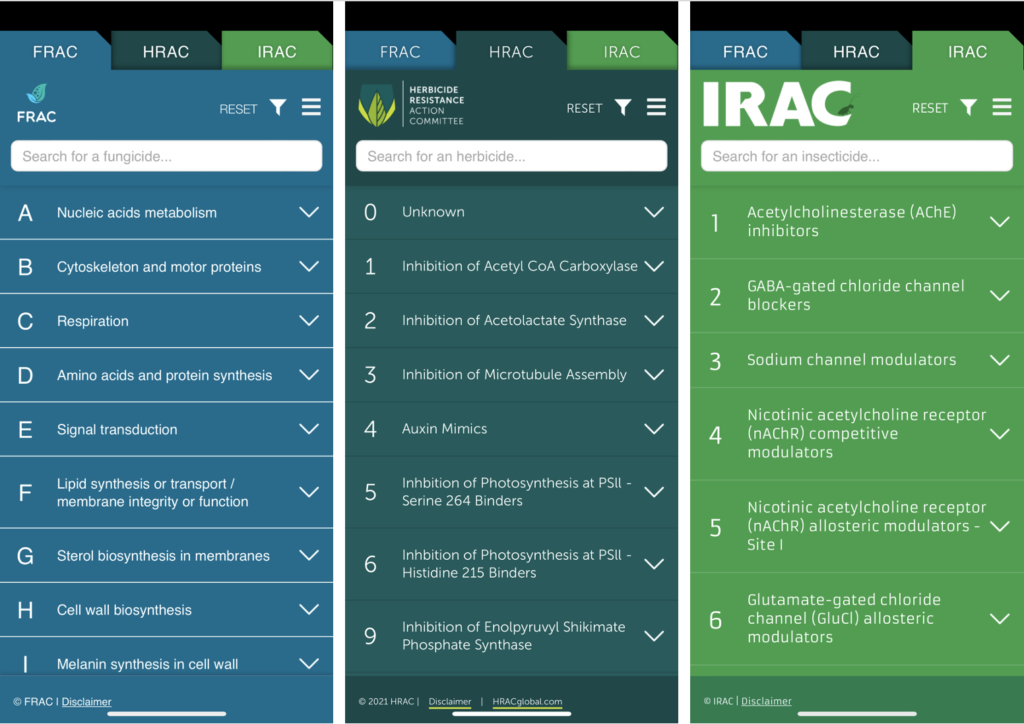Mode of Action Team News
-
Latest updates to the MoA Classification (version 11.3)
Nonanoic acid has been added to MoA Group UNE (Botanical essence including synthetic, extracts and unrefined oils with unknown or uncertain MoA)
The updated resources, available for download from the IRAC website, are:
-
Pest MoA Posters Updated to correspond with the latest MoA Classification
The updated posters using the information from the latest version of the MoA Classification (Version 11.2, January 2025) and covering Lepidoptera, Sucking Pests, Mites, and Mosquitoes can be downloaded using the embedded links
-
Latest updates to the MoA Classification (version 11.2)
New versions (11.2, August 2024) of the IRAC MoA resources have been released and posted on the website. The changes include the following updates:
- Group 37: A new MoA Group which has been named “Vesicular acetylcholine transporter (VAChT) inhibitors”.
- Group 37: Oxazosulfyl has been moved from Group UN to the new Group 37.
- Group UNE: Sabadilla Extract has been classified as “Botanical essence including synthetic, extracts and unrefined oils with unknown or uncertain MoA”
- Group UNM: Polydimethylsiloxane (PDMS) has been classified as “Non-specific mechanical and physical disruptors”
- Group 35: Vadescana has been classified as “RNA Interference mediated target suppressor” in the MoA Classification under Appendix 6 as pending registration.
- Group UNM: Perlite has been classified as a “Non-specific mechanical and physical disruptor” in the MoA Classification under Appendix 6 as pending registration.
The updated resources, available for download from the IRAC website, are:
-
New versions (11.1, January 2024) of the IRAC MoA classification and associated resources have just been released and posted on the website.
The Changes include the following updates:
Group 4E Nicotinic acetylcholine receptor (nAChR) competitive modulators – New Active: Fenmezoditiaz
Group 23: Inhibitors of acetyl-CoA carboxylase – New Active: Spidoxamat.
Group 35 RNA Interference mediated target suppressors New Group and Active: Ledprona
Group UNF Fungal agents of unknown or uncertain MoA New Fungal Agent added: Akanthomyces muscarius Ve6Resources:
-
Latest updates to the MoA Classification
New versions (10.5, March 2023) of the IRAC MoA resources have just been released and posted on the website. The changes include the following updates:
- Group 29: Renamed to “Chordotonal organ nicotinamidase inhibitors”.
- Group 36: A new MoA Group which contains the active Dimpropyridaz, and is named “Chordotonal organ modulators – undefined target site”.
- Dicloromezotiaz, previously, in Appendix 6 (active ingredient pending registration), has been moved to Group 4E, Mesoinics, within Group 4, “Nicotinic acetylcholine receptor (nAChR) competitive modulators”.
- The new peptide, U1-AGTX-Ta1b-QA, has been classified as “Unknown or uncertain MoA – subgroup UNP (peptides of unknown or uncertain MoA)” and has been added to the Classification Scheme, Appendix 6, pending registration.
The updated resources, available for download from the IRAC website, are:
-
New IRAC, HRAC and FRAC Global Resistance Management Mode of Action App
The new Global Resistance Management (GRM) Mode of Action App, released earlier this year by the Resistance Action Committees (IRAC, HRAC FRAC), has just been updated with additional features. The App combines the information on the Resistance Action Committee’s standalone Mode of Action Apps into one application for ease of access by the user. The individual IRAC, FRAC and HRAC Mode of Action Apps are still available and all applications can be downloaded from the Apple App and Google Play stores.

-
Latest MOA Classification Update
The latest edition of the scheme, version 10.3, has now been published which includes some minor changes to the earlier versions.
Download the latest Mode of Action Classification.
-
Updated MoA Resources now published in Japanese
The updated Japanese translated versions of the IRAC MoA Classification Scheme, the Classification Table, the MoA Poster showing the chemical structures, the Procedure for classification of new actives and MoA labeling advice has now been posted on the website with links on the Japan and MoA landing pages.
-
IRAC Mode of Action Posters and Brochure updated
The MoA posters with the chemical structures for insecticides/acaricides and for nematicides and the small MoA brochure (now including nematicides) have been updated to correspond with the latest versions of the IRAC MoA Classification. The documents can be downloaded from the website and printed copies will be available in early 2022. The insecticide/acaricide poster is in English but other language version are in preparation.
-
New Thai and Vietnamese language versions of the IRAC IRM and MoA videos
A full list of the languages versions available are copied below.
Mode of Action:
English, Spanish, Portuguese, Mandarin Chinese, French, Italian, Korean, Arabic, Russian, Bahasa(Indonesian), Khmer , Japanese , Tagalog (Philippines), Hindi, German, Thai, VietnameseInsecticide Resistance Management:
English, Spanish, Portuguese, Mandarin Chinese, Japanese, Hindi, French, Italian, Korean, Arabic, Russian, Bahasa (Indonesian), Russian, Tagalog (Philippines), German, Thai, Vietnamese